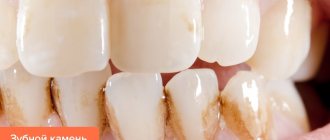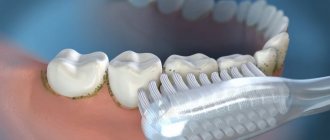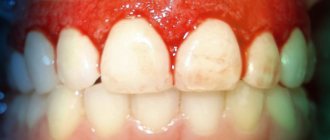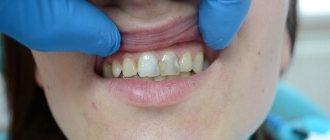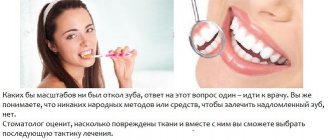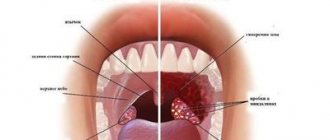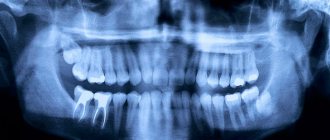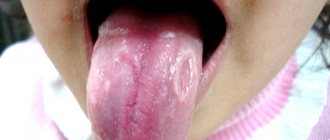How does tartar form on baby teeth in children?
The formation of tartar in children under 3 years of age, and in adults as well, begins with the deposition of soft bacterial plaque, which undergoes progressive calcification: calcium phosphate minerals are deposited both within and between the plaque bacteria, and then again covered with a layer of plaque. Thus, a hard mineralized plaque appears on the teeth, mainly in the front part, which cannot be removed with a children’s toothbrush. The usual color of tartar in adults is brown. But in children under 3 years old it is usually green. According to dentists, the appearance of such plaque is associated with the vital activity of chromogenic microorganisms containing chlorophyll, which, as we know, is green.
Description of the problem
Contrary to popular belief, tartar occurs not only in adults, but also in very young children. Of course, plaque formation on children’s teeth does not occur in one day, but 3-4 weeks is enough for visible deposits to appear.
In one-year-old babies
At one year of age, the baby almost completely switches from breastfeeding to adult food.
However, the saliva of a small child does not yet have the properties of the saliva of an adult - too little time has passed since the baby fed only mother’s milk or formula.
In addition, not all parents by this age begin to pay close attention to the child’s oral hygiene, teaching him to brush his teeth.
Often, a mother, fearing that her one-year-old baby might swallow toothpaste and harm himself, postpones teaching hygiene skills to a later date.
At the age of 2 years
By the age of two, the baby’s diet expands even more, however, it is often at this age that the child learns what sweets are. Constant and sometimes uncontrolled consumption of sweets disrupts the acid-base balance of the oral cavity. In addition, at this age, children are not yet able to fully care for their teeth, even if they already have the skill of brushing them.
Important! Almost all cases of tartar in children are associated with metabolic disorders.
If a child takes proper care of his mouth and eats sweets only occasionally, under the supervision of his parents, he will not be at risk of developing tartar. The only exceptions may be rare, genetically determined cases, or cases of exposure to negative factors on the fetus during intrauterine development.
At the age of 3 years
At the age of three, most children begin to attend kindergarten and oral hygiene, at best, comes down to morning and evening brushing of teeth.
During a daily stay in a kindergarten group, a child eats at least three times, without carrying out any hygiene procedures afterwards - not even basic rinsing of the mouth.
Food served in children's establishments typically has an extremely soft, mushy or puree-like consistency. Lack of solid foods in the diet is one of the reasons for the formation of plaque, especially in hard-to-reach areas of the oral cavity.
On baby teeth: causes of appearance
- In most cases, the front teeth and canines are the first to be affected in young children, due to bottle feeding. The sweet mixture gets on the teeth, and the resulting plaque hardens over time and turns into tartar.
- A particular problem is posed by night feedings , after which the child immediately falls asleep without any hygiene procedures or at least rinsing the mouth. The formation of deposits over time can lead to bottleneck caries.
- In older children, the main factor provoking the formation of plaque, and subsequently tartar, is the abundance of carbohydrate foods , which disrupt the acid balance and insufficient oral hygiene.
On permanent teeth
The main reasons for the appearance of tartar on permanent teeth are the same as on milk teeth – carbohydrates and insufficient hygiene. An additional factor may be the incorrect selection of a toothbrush.
The enamel of permanent teeth is stronger, which means that stiffer bristles are required. And the area of the cleaning surface of the toothbrush should correspond to the age of the child. It is advisable to use a brush with artificial rather than natural bristles, since bacteria multiply faster in natural bristles.
Causes of tartar in children
Local factors play a large role in the formation of tartar in a child aged 2 years and older. First of all, this is poor oral hygiene in children. Also, the causes of tartar include insufficient consumption of solid foods. In addition, the occurrence of a large amount of tartar may be a consequence of the lack of pyrophosphate in the saliva, which retards the development of dental plaque, or the lack of a certain protein in the saliva, which slows down the growth of crystals. The presence of tartar on children's teeth is not always obvious. Calcium phosphate crystals can be closely bound to the surface of the enamel, making it often difficult for the dentist to discern where the enamel ends and the stone begins.
What could be the consequences?
If measures are not taken in a timely manner to remove the stone, it can provoke a lot of serious consequences for the condition of the oral cavity and the entire body as a whole. Thus, dental deposits can lead to the development of caries, gingivitis, periodontitis and periodontal disease. Inflammatory processes in soft tissues are usually accompanied by bleeding, exposure of roots and the appearance of swelling. As a result, the patient may encounter the following problems:
- dental diseases associated with the condition of the mucous membrane,
- inflammatory processes in the gums,
- carious lesions: from caries to pulpitis and periodontitis,
- halitosis – the appearance of an unpleasant odor from the mouth,
- exacerbation of general diseases of the body - diabetes mellitus, disorders of the cardiovascular system, malfunction of the ENT organs and the immune system, and others,
- general deterioration in well-being and health of the entire body as a whole.
Caries in a child can cause tartar.
But the most dangerous problem can be the premature loss of a baby tooth, which will ultimately negatively affect the formation of a permanent bite, especially if parents do not pay due attention to prosthetics of the lost element of the smile. Yes, even small children need this procedure if necessary.
Types - place of formation and color
In dentistry, there are two types of tartar - supragingival and subgingival. They are distinguished by their location on the surface of the tooth. The first is visible to the naked eye and has a grayish or whitish-yellow color. It is easily removed by scraping. Minerals coming from saliva participate in the formation of supragingival tartar. It is most often localized in the area of the lower front teeth and the buccal surfaces of the maxillary molars, where the ducts of the salivary glands open.
Subgingival tartar can only be detected by a dentist during probing. It is formed due to minerals coming mainly from the gingival fluid. As a rule, it is dark brown in color with a greenish tint, localized on the neck of the tooth within the gingival groove, on the root cement, in the periodontal pocket. Covering the neck of the tooth, the stone is tightly attached to its surface, and often forms protrusions.
Tartar removal in children
How to remove tartar from a child? If you find your child has tartar, the first thing you need to do is make an appointment at a pediatric dentist. On the first visit, the child undergoes professional teeth cleaning: soft plaque and dental deposits are removed. Removal of subgingival tartar in children is carried out using ultrasound under local anesthesia. After the procedure, the doctor explains to parents how to monitor whether the baby is brushing his teeth correctly. Before and after the procedure, the hygiene index is checked, and the rules of oral care are repeated in the presence of parents. After 1 - 2 weeks, an appointment is made to monitor the thoroughness of dental plaque removal.
How to prevent dental plaque
Tartar forms in the oral cavity of almost every person. But it is within our power to slow down this process. To do this you need:
- brush your teeth regularly, twice a day;
- thoroughly clean the surface of the teeth from the inside and outside;
- rinse your mouth after every meal;
- The bristles of the toothbrush should be hard enough to remove plaque, but soft and elastic so as not to injure the gums;
- The gaps between the teeth should be treated with dental floss or an irrigator. This is important, since this is where plaque accumulates in very large quantities;
- Choose your toothpaste carefully. If it contains pyrophosphates, plaque will form more slowly. But such a paste can only be used in courses, between which a break should be taken.
Prevention measures
- As noted above, the absence of a substance such as pyrophosphate can lead to the formation of tartar. Therefore, some toothpastes contain this component. It stops the mineralization of tartar and prevents the process of new growth. The addition of pyrophosphate to toothpastes to some extent compensates for the lack of a natural analogue in saliva. When choosing a paste with this substance, pay attention to what age children it is recommended for.
- A properly selected children's toothbrush will also help prevent the appearance of tartar in children. It is best to prefer a brush with artificial bristles, since, unlike natural bristles, microorganisms do not form in it. Naturally, you need to remember that you should change your toothbrush every three months. In the meantime, until your child reaches the age when he can brush his teeth on his own, you can use special napkins to clean his teeth. They contain xylitol, which inhibits the growth of bacteria on teeth and gums and cleanses them well of soft plaque. Also relevant in this case are fresh hard fruits and vegetables: apples, carrots, cabbage.
- In order for oral hygiene to be as effective as possible, it is very important to teach your child how to brush their teeth properly. Among the main recommendations of dentists, we highlight the following: first, we clean the upper jaw from the outside and inside, starting from the sides, then the front teeth from top to bottom. On the lower jaw the sequence is the same, only the brush moves from bottom to top. Do not forget about the hygiene of the mucous membranes of the cheeks, palate and tongue, where a large number of bacteria are formed.
- Parents need to monitor their children's oral hygiene and regularly take them to the pediatric dentist. This will help prevent the formation of tartar, which can cause various oral diseases, for example, gingivitis in children, childhood periodontitis, and various types of stomatitis in children. In addition, your child's bad breath will also not bother you. Teeth with children's braces will need special care. Remember that food debris and soft plaque can be easily removed with a toothbrush and toothpaste. Removal of mineralized dental deposits is carried out only by a hygienist using special means and instruments.
Symptoms and consequences of tartar
Patients experience the following symptoms:
- bad breath;
- bleeding gums;
- caries;
- purulent discharge;
- gingivitis;
- pulpitis;
- periodontitis – inflammation of tissue areas near the root of the tooth;
- mobility and tooth loss.
Gingivitis
The initial form of gum disease.
If left untreated, gingivitis can develop into periodontitis, which is a serious, irreversible gum disease and the most common cause of tooth loss in adults.
The main 4 signs of gingivitis:
- Bleeding gums. Healthy gums do not bleed. If blood comes out when using a toothbrush or floss, this may indicate the onset of gingivitis. Even if it happens from time to time. The symptom should not be ignored as it may be a sign of the onset of gum disease.
- Unpleasant smell. There are many reasons for a bad odor: specific foods, poor hygiene, but it can also be the first sign of gingivitis. This is due to the fact that the bacteria that cause gum disease produce an unpleasant odor by breaking down food particles in the mouth.
- Swollen gums. They are usually pink and firm. Redness and swelling may indicate the onset of the disease.
- Receding gums. They begin to separate, and the root of the tooth is exposed, the incisors appear longer. Increased sensitivity is another sign.
A common cause of toothache is inflammation of the dental nerve, called pulpitis. Anyone suffering from this should seek help from a dentist as soon as possible.
Pulpitis
In acute pulpitis, pain usually occurs spontaneously. The pain may be constant or occur periodically. In rare cases, the inflammatory process is completely painless.
If the affected tooth is sensitive to pressure and impact, this is a sign of a dead dental nerve. It hurts when you touch the tongue, but especially when you squeeze it. The pain is often worse at night, as the warmth of the bed increases the inflammatory process. If left untreated, bacteria from the medullary cavity of the tooth can penetrate through the hole at the root tip into the surrounding bone and soft tissue. Accordingly, inflammation spreads, the cheek and lymph nodes swell.
Periodontitis
Periodontal disease is defined as chronic inflammatory disease of the gums. It is mainly caused by bacterial plaque (biofilm, plaque), especially in old age.
As a result of inflammation, your teeth may hurt and your gums may bleed more easily. If left untreated, periodontitis can also lead to tooth loss.
Patients with periodontitis usually show few symptoms at first. However, some signs may indicate the disease:
- bleeding gums;
- red and swollen gums;
- Gum recession;
- open and sensitive necks of teeth;
- putrid odor from the mouth;
- unpleasant taste, especially when pus leaks from the inflamed areas;
- The spaces between the teeth widen;
- loose teeth, misaligned teeth.

